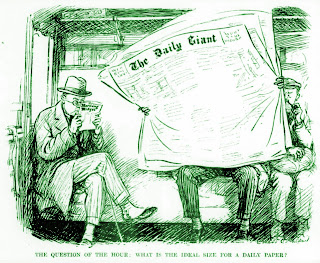At Authority Magazine (Medium) in February and March there
is a series of 25 articles resulting from interviews with Fotis Georgiadis on
the Five things you need to be a highly effective public speaker. Those five
things are the main take-away. (The interviews also asked a long series of
other questions). Here are the dates, interviewees, and their five things:
February 13, 2022
Julie Navickas [university communications instructor]:
Understand Your Audience
Engage Your Audience
Be Aware of Your Non-Verbal Communication
Use Humor Effectively
Practice
Natalie Sullivan of Vegas Improv Power:
Know what you know.
Know what you don’t know.
Care about what you are saying.
Comfort in discomfort
Connection.
February 16, 2022
Jennifer Best of AAE Speakers Bureau:
Your “why.”
Lots of practice.
A niche.
A compelling story.
A community.
Andrea Heuston of Artitudes:
Audience Research.
Location Research.
Practice. Practice. Practice
Hook them with an opening ‘heart’ story.
Pay attention to language and cadence.
Lynn Mason-Pattnosh of ConciergeQ Media:
Public speaking as performance.
Smile.
Breathe.
Audience.
Pressure is a privilege.
Dr. Angelia Registad [communication consultant and coach]:
Be Authentic and Vulnerable
Tell a Story
Use Visuals
Be Organized and Prepared
Practice, Practice, Practice
February 20, 2022
Keenan Beavis of Longhouse Media:
Understand that being nervous is completely normal.
Confidence in yourself.
Belief in what you’re saying.
Individuals, not a crowd.
Practice. Practice. Practice.
Kyle Bose of Kettering Fairmont High School:
Great body language.
Inflection of voice.
Pacing.
Knowledge.
Awareness.
LaQuita Cleare of Clear Communication Academy:
Ability to have a conversation
Storytelling skills
A powerful hook: first impressions matter
Dynamic delivery skills
A clear message
Maria Cormier of Emerging Leader Training:
Greet people at the door.
Get the audience involved.
Make it a conversation.
Know your topic.
Gain confidence through practicality.
Dan Faill of Faill Safe Solutions:
Your Mindset
Your Message
Your Story
Your Speaker Friends
Your Voice
Jonathan George of Unleash Your Rockstar Personal Branding
Agency:
Clarity
Content.
Preparation.
Practice.
Tommy Hilcken [speaking coach]:
You must be trained.
Be confident.
Be prepared.
Do the biz.
Love what you do.
Joseph McClendon III of the Neuroencoding Institute:
Identification.
Logic/Reason.
Attack and confess.
Solution.
Assume the action.
Simba Nyazika of Lenica Research Group:
Have a clear vision
(why) for the presentation.
Clarify the one primary thing you want the audience to leave
with or to do.
Use stories to engage and make your speech memorable.
Use your non-verbal behaviour to make your speech more
impactful.
Make eye contact with sections of the audience, especially
during key portions which you want them to remember.
February 23, 2022
Paul Krismer [keynote speaker]:
Genuinely have something to say.
Be in a business frame of mind.
Be a bit funny.
A good talk is filled with stories that leave an emotional
impact.
Prioritize (individualize) your audience for every speech.
February 27, 2022
LeAnn Brazeal of Missouri State University:
Authenticity.
Conversational style.
Appropriate practice.
Passion for your topic.
Content you’re proud to share.
Kelly Charles-Collins [attorney and TEDx speaker]:
You must know what you are going to speak about, who you are
going to speak to, what you are going to charge, who will pay you for what you
are speaking about, what is the value you will provide.
Whatever your rate is, you must be able to say it and shut
up.
Be authentically you.
You must have a depth of knowledge about your topic.
Who you say you are on social media, your website, marketing
materials, etc. must be congruent with who shows up for a client.
Debra Jason of The Write Direction:
D is for dream.
A is for authenticity.
N is for nurture.
C is create connection.
E is for engagement.
March 1, 2022
Maria DiLorenzo of MFD Style:
Practice
Pay attention to your speech cadence
Get personal
Be emotive
Believe in yourself and your message
March 6
Jon Saunders [business leader]:
Practice! Practice!
Practice!
Bring energy to the presentation.
Content. Balance between actual points you are trying to
make and stories.
Deliver your presentation with a calm confidence.
If using a PowerPoint, remember that less is more.
Kyle Slaymaker of The Slaymaker Method:
Be your authentic self.
Be honest.
Be confident.
Place yourself behind others.
Learn from your audience.
March 8, 2022
Holly Dowling [keynote speaker]:
Lose your ego.
Find your “why.”
Throw out the script and stop memorizing!
Be relatable, be trustworthy, and be empathetic.
Start focusing on bringing your light to your message so you
can shine a light on everyone else.
March 10, 2022
Matias Rodsevich of PR Lab:
Confidence brings credibility and authenticity.
Being yourself relates to your ability to keep it natural.
Relating to the audience also establishes a connection that
helps convey what you are saying.
Keeping it short is vital.
Lastly, practicing your speech is a guarantee for having the
natural flow needed.
March 13, 2022
Jackie Kallen of Bruce Merrin’s Celebrity Speakers Bureau:
Motivate.
Inspire.
Entertain.
Be creative.
Share your personality.
What words show up most in those lists of five things? They
are: practice (10), confidence (6), story (6), audience (5), clarity (3),
conversation (3), and why (3).
Dan Faill claimed that:
“In fact, nearly 77% of people have glossophobia, or fear of
public speaking.”
But back on October 12, 2020 I blogged about Do 77% of
Americans fear public speaking? No! That percentage described stage fright in
Swedes who also had social anxiety disorder.






















